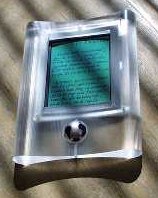
@folio is a reading device conceived in October 1996 by Pierre Schweitzer, an architect-designer living in Strasbourg, France. It is meant to download and read any text and/or illustrations from the web or hard disk, in any format, with no proprietary format and no DRM.
The technology of @folio is novel and simple, and very different from other reading devices, past or present. It is inspired from fax and tab file folders. The flash memory is “printed” like Gutenberg printed his books. The facsimile mode is readable as is for any content, from sheet music to mathematical or chemical formulas, with no conversion necessary, whether it is handwritten text, calligraphy, free hand drawing or non-alphabetical writing. All this is difficult if not impossible on a computer or any existing reading device.
The lightweight device is built with high-quality materials, and the LCD screen takes 80% of the total surface and has low power consumption. The screen is surrounded by a translucent and flexible frame that folds to protect the screen when not in use. The data is downloaded through a USB or Bluetooth connection.
Readers will appreciate the device is much cheaper and lighter than a laptop or a notebook computer, and has a larger screen than the one provided by a PDA, a cell phone or a smartphone. This product could be sold for [about] 100 $US for the basic standard version, with various combinations of screen sizes and flash memory to fit the needs of architects, illustrators, musicians, specialists in old languages, etc.
Intuitive navigation allows the reader to “turn” pages as easily as in a print book, and to classify and search documents as easily as with a tab file folder. The reader can choose his/her preferences for margins, paragraphs, font selection and character size. No buttons, only a round trackball adorned with the world map in black and white (or another color). The trackball can be replaced with a long and narrow tactile pad on either side of the frame.
The flash memory allows the downloading of thousands of hypertext pages previously linked before download or linked during the downloading process. @folio provides an instant automatic reformatting of documents, for them to fit the size of the screen. For “text” files, no software is necessary. For “image” files, the reformatting software is called Mot@Mot — French for Word@Word — and could be used with any other device. This software received much attention from the French National Library for a potential use in Gallica, its digital library of 90,000 books, especially for old books (published before 1812) and illustrated manuscripts.
Since its inception, the @folio project has received a warm welcome during guest presentations in various book fairs and symposiums in France and Europe, and a warm welcome from the French-speaking media — press, radio, television and internet. An international patent was filed in April 2001. The French startup iCodex was created in July 2002 to promote, develop and market @folio. Five years later there is still a warm welcome, but yet no funding. The @folio team hopes to find the right partners in 2008.
Pierre Schweitzer would be pleased to show a prototype, and answer any question about the device and its components. [For any questions in English by email and in person relating to tech questions, he will need the help of a tech translator from French to English.]
Pierre Schweitzer’s passion for a cheap and beautiful reading device intended for everybody — and not just the few — has no boundaries… except some financial ones.
A Few Milestones
- 1996 (October): Conception of the reading device
- 2001 (April): Filing for an international patent
- 2002 (July): Creation of the French start-up iCodex
- 2007 (August): First contacts abroad (outside France)
— Marie Lebert, August 2007
N.B.
Please also see an interview with Pierre Schweitzer in French.
Marie Lebert is a researcher and writer specializing in digital technology relating to books, other media and languages. With many thanks to Michael Hart, founder of Project Gutenberg, who kindly proofread this article.
[Updated 2007-10-15: Some minor changes to the text and link updates by Marie — Ed.]